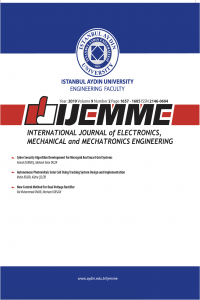Experimental Studies on Determination of Discharge Capacity of Circular Labyrinth Weirs Located on A Straight Channel
Experimental Studies on Determination of Discharge Capacity of Circular Labyrinth Weirs Located on A Straight Channel
Fluid Mechanics; Discharge coefficient; Circular; Trapezoidal; Labyrinth weir, Dam Safety,
___
- Yıldız D., Uzucek E. (1993) Labirent dolusavakların projelendirilme kriterleri. Devlet Su İşleri Teknik Araştırma Kalite ve Kontrol Dairesi Başkanlığı. Yayın No: HI-862 Ankara.
- Crookston, B. M., and Tullis, B. P. (2012c) Labyrinth weirs: Nappe interference and local submergence. J. Irrig. Drain. Eng., 138(8), 757–765.
- Falvey, H.T., (2003) Hydraulic Design of Labyrinth Weirs. ASCE Press, 162p.
- Darvas, L. (1971) Discussion of performance and design of labyrinth weirs, by Hay and Taylor. J. Hydraul. Eng., ASCE, 97(80), 1246–1251.
- Yıldız, D., Uzucek, E. (1996) Modeling the performance of labyrinth spillways. Int. J. Hydropower Dams, 3, 71–76.
- Tsang, C. (1987) Hydraulic and aeration performance of labyrinth weirs. Ph.D. dissertation, University of London, London.
- Taylor, G. (1968). The performance of labyrinth weirs. PhD thesis, University of Nottingham, U.K.
- Hay, N., and Taylor, G. (1970) Performance and design of labyrinth weir. J. Hydraul. Eng., 96(11), 2337–2357.
- Houston, K. (1982) Hydraulic model study of Ute dam labyrinth spillway. Rep. No. GR-82-7, U.S. Bureau of Reclamation, Denver.
- Houston, K. (1983) Hydraulic model study of Hyrum dam auxiliary labyrinth spillway. Rep. No. GR-82-13, U.S. Bureau of Reclamation, Denver.
- Babb, A. (1976). “Hydraulic model study of the Boardman Reservoir Spillway.” R.L Albrook Hydraulic Laboratory, Washington State University, Pullman, Wash.
- Crookston, B. M., and Tullis, B. P. (2011) “The design and analysis of labyrinth weirs” 31st Annual USSD Conference. San Diego, California, April 11-15, Pages: 1667-1681.
- Lux, F., (1989) Design and Application of Labyrinth Weirs, Design of Hydraulic Structures 89, Balkema, Rotterdam, ISBN, 90, 6191 – 8987.
- Magalhaes, A., and Lorena, M. (1989) Hydraulic design of labyrinth weirs. Rep. No. 736, National Laboratory of Civil Engineering, Lisbon, Portugal.
- Tullis, B. P., Amanian, N., and Waldron, D. (1995) Design of labyrinth weir spillways. J. Hydraul. Eng., ASCE, 121(3), 247–255.
- Tullis, B. P., Young, J., and Chandler, M. (2007) Head-discharge relationships for submerged labyrinth weirs. J. of Hydraul. Eng., ASCE, 133(3), 248–254.
- Savage, B., Frizell, K., and Crowder, J. (2004) “Brains versus brawn: The changing world of hydraulic model studies”. ASDSO 2004 Annual Conf. Proc., Association of State Dam Safety Officials (ASDSO), Lexington, KY. May, 4. 〈www.usbr.gov/pmts/hydraulics_lab/pubs/PAP/PAP-0933.pdf〉.
- Emiroglu, M. E., Kaya, N., and Agaccioglu, H. (2009).“Discharge capacity of labyrinth side weir located on a straight channel.”J. Irrig. Drain. Eng., ASCE, 136(1), 37–46.
- Kaya, N., Emiroglu, M. E., and Agaccioglu, H., (2011) “Discharge coefficient of a semi-elliptical side weir in subcritical flow.” Flow Measurement and Instrumentation, Volume: 22, 25-32.
- Bilhan, O, Emiroglu, M. E., Kisi, O, (2011) Use of artificial neural networks for prediction of discharge coefficient of triangular labyrinth side weir in curved channels. J. Advances in Eng. Soft. 42(4), 208-214.
- Khode, B.V., Tembhurkar, A.R. Porey, P.D. and Ingle R.N. (2011) Determination of Crest Coefficient for Flow over Trapezoidal Labyrinth Weir. World Applied Sciences Journal 12 (3): 324-329.
- Khode, B. V., Tembhurkar, A. R. P. D. Porey and R. N. Ingle, (2012) Experimental Studies on Flow over Labyrinth Weir. Journal of Irrig. Drain Eng. ASCE, 138:548-552.
- Anderson, R. M. and Tullis, B. P., (2012) Comparison of Piano Key and Rectangular Labyrinth Weir Hydraulics. J. Hydraul. Eng. 138:358-361.
- Carollo, F., Ferro, V., and Pampalone, V. (2012). Experimental Investigation of the Outflow Process over a Triangular Labyrinth-Weir. J. Irrig. Drain Eng., 138(1), 73–79.
- Crookston, B. M., and Tullis, B. P. (2012a) Arced labyrinth weirs. J. Hydraul. Eng., 138(6), 555–562.
- Crookston, B. M., and Tullis, B. P. (2012b) Discharge efficiency of reservoir-application-specific labyrinth weirs. J. Irrig. Drain. Eng., ASCE, 138(6), 773–776.
- ISSN: 2146-0604
- Başlangıç: 2011
- Yayıncı: İstanbul Aydın Üniversitesi
Control of Fuel Cell Power System
Ayşe KOCALMIŞ BİLHAN, Caisheng WANG
Circularly Polarized Slot Antenna for wireless Applications
Yasin AMANI, Yashar Zehforoosh
An Optimization Model And Genetic Algorithm Solution For Software Projects
Yücel DİL, Mustafa Cem KASAPBAŞI
A Prediction Model For Performance Analysis in Wireless Mesh Networks
